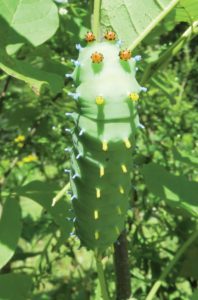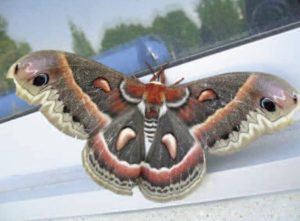SCORES & OUTDOORS: Big green caterpillar
 SCORES & OUTDOORS
SCORES & OUTDOORS
by Roland D. Hallee
Last week a reader sent a photograph of a caterpillar that she couldn’t identify (see photo).
The photo she sent shows the Hyalophora cecropia in its fifth instar (stage) of development, or the cecropia moth caterpillar. It is the largest native North American moth.
The female moth has had its wings measured up to six inches or more. Its range is from Nova Scotia in eastern Canada and Maine south to Florida, and west to the Canadian and U.S. Rocky Mountains. It can also be found in California.
Like all members of the giant silk moth family, the moths only reproduce because they lack functional mouth parts or digestive system, meaning they never eat. Therefore, the life expectancy is only about two weeks.
The female lays up to 100 eggs, which hatch into tiny black caterpillars. The larvae feed upon many common trees and shrubs, including maple, birch and apple. The larvae are more commonly found on maple trees. As they grow larger, it becomes clear that the black color is actually small hairs growing. In the early stages they are yellow-green. As they grow larger, the colors change to green to bluish-green, with the tubercles becoming blue, yellow and orange. Upon reaching matu-rity in autumn, the caterpillar, now about four inches long, spin large cocoons on trees or wooden structures to emerge as adults in the first two weeks of seasonally warm weather in early summer. They only have one generation per year.
Pests of the moth have become a significant problem. Parasites such as wasps and flies lay their eggs in or on the young caterpillars. The eggs then hatch into larvae, which consume the internal organs and muscles of the caterpillars. Once the eggs hatch into larvae, the para-sites release chemicals that override the regulatory mechanisms of the caterpillar, and will eventually kill the cecropia pupa. Squirrels also consume the pupae of the cecropia moths, which decreases the population significantly. Pruning of trees and leaving outdoor lights on at night can also be detrimental to the moths.
The wings of the moth are brownish with red near the base of the forewing. Crescent-shaped spots of red with whitish center are obvious on all wings, but are larger on the hindwings. All wings have whitish coloration followed by reddish bands of shading beyond the postmedial lie that runs longitudinally down the center of all four wings. The body is hairy with reddish color-ing. The body has alternating bands of red and white.
The coloration of the moth is so spectacular they are prized by collectors and nature lovers, specifically for their large size and extremely showy appearance.
Now you can impress your friends when someone sees one of these and you can identify it as the Hyalophora cecropia.
Responsible journalism is hard work!
It is also expensive!
If you enjoy reading The Town Line and the good news we bring you each week, would you consider a donation to help us continue the work we’re doing?
The Town Line is a 501(c)(3) nonprofit private foundation, and all donations are tax deductible under the Internal Revenue Service code.
To help, please visit our online donation page or mail a check payable to The Town Line, PO Box 89, South China, ME 04358. Your contribution is appreciated!




Leave a Reply
Want to join the discussion?Feel free to contribute!